Study on Membrane Damage and Collapse of Air-Supported Structures under Fire Conditions
Abstract
:1. Introduction
- Traditional fireproofing systems, such as automatic spraying systems, cannot be used in air-supported structures;
- The air-supported membrane structure cannot be separated by a firewall, so air-supported structures are mostly used as an entire fire partition. However, the indoor areas of air-supported structures generally exceed the area of the fire zone allowed by safety codes;
- In order to ensure the sealing performance of an air-supported structure, air-supported structures usually use revolving doors for personnel entrances and exits and airlock gates for the entrance and exit of automobiles and other large machines. However, revolving doors and airlock gates cannot be used as emergency exits;
- Damage to unstructured walls is allowed in traditional structures. However, any membrane damage in air-supported structures may lead to the collapse of the entire structure.
2. Temperature of Air-Supported Structure in Event of Fire
2.1. Geometry and Mesh
2.2. Material and Boundary
2.3. Results
3. Failure of the Air-Supported Structure in the Fire Event
3.1. Strength of Membrane at High Temperature
3.2. Failure of Air-Supported Structures at High Temperature
3.2.1. Geometry and Mesh
3.2.2. Material, Boundary, and Steps
- (1)
- An implicit dynamic step—pressure difference was loaded in this step;
- (2)
- An implicit dynamic step—gravity was loaded in this step;
- (3)
- An implicit dynamic step—no new loads were added in this step. The vibration caused by loading gradually stops in this step;
- (4)
- A static step—all the vibrations were stopped and a static solution is found;
- (5)
- An implicit dynamic step—the temperature in the fire was loaded in this step. The step ended when the membrane started to fail.
3.2.3. Result
4. Leakage of the Air-Supported Structures
4.1. Leakage and Collapse of Air-Supported Structures
4.2. CFD Model of the Leakage Stage
5. Parameter Analysis
5.1. Stress of the Weld Joint
5.2. Temperature of the Weld Joint
5.3. Leakage and Collapse of the Structure
6. Conclusions
- In the event of a fire, only the membrane above the ignition source is significantly heated. The air-supported membrane structure may fracture at the welded joints. The leakage area caused by weld failure is less than 2% of the open area of the emergency door. In case of fire, all the safety doors of the air-supported structure will be opened for evacuation. Indoor air leaks occur mainly through safety doors in the fire cases;
- The leakage model proposed in this paper can be used to estimate the leakage rate and collapse time of air-supported structures. Although the model assumes a constant temperature, the error is less than 4% when it is used to study the collapse of air-supported membrane structures in a fire;
- The membrane temperature rise rate decreased significantly with corresponding increases in the height of structures. Therefore, the fracture time of the structure is also significantly prolonged. The fracture time increased from 5 min to 471 min when the height of the structure increased from 7 m to 28 m. The collapse time increased from 9 min to 39 min. There is no significant difference in the leakage time of different structures. With the structure span increasing from 20 m to 80 m, the proportion of the fracture time in the structure destruction time increased from 34% to 92%;
- When the structure begins to collapse, emergency exits may be blocked by membranes and be impassable. The evacuation time is the sum of the fracture and leakage times with the time before the emergency exits are blocked during the collapse stage. The fracture stage occupied 60% of the evacuation time when the span was 20 m, and 93% when the span was 80 m.
Author Contributions
Funding
Data Availability Statement
Acknowledgments
Conflicts of Interest
References
- Cheng, Z.; Xue, S.; Li, X. Research progress and prospect on fire resistance of air supported membrane structure coal shed. Build. Struct. 2021, 51 (Suppl. S1), 583–587. [Google Scholar]
- ASCE. Air-Supported Membrane Structures; ASCE 17-96; American Society of Civil Engineers: New York, NY, USA, 1997. [Google Scholar]
- CECS. Technical Specification for Membrane Structures; CECS 158:2015; China Association for Engineering Construction Standardization: Beijing, China, 2015. [Google Scholar]
- Liang, J. The Research on the Characteristics of Air Temperature of Large Space Structures in Fire Considering the Effect of Smoke Emission; Beijing University of Technology: Beijing, China, 2010. [Google Scholar]
- Liang, J. Research on the Model of Temperature Field in Large-Space Fire with Curved Surface; Beijing University of Technology: Beijing, China, 2013. [Google Scholar]
- Tao, Y. Study on Temperature Field Distribution of Spherical Dome and Cable Dome Structure Response under Large Space Fire; Beijing University of Technology: Beijing, China, 2017. [Google Scholar]
- Wu, J. Fire Numerical Simulation of Air-Supported Membrane Structures and Study on High Temperature Mechanical Properties of P-Type Membrane Materials; Beijing University of Technology: Beijing, China, 2019. [Google Scholar]
- Shen, Y.; Wang, Z.; Peng, C.; Wu, B. Fire temperature fields and smoke distribution of rectangular plane air-supported membrane structure. Ind. Constr. 2014, 44, 78–82. [Google Scholar]
- Yi, S.; Zen, B. Study on the fire temperature field characteristics of inflatable membrane structure. Fire Sci. Technol. 2016, 35, 1507–1510. [Google Scholar]
- Zhang, H. Simulation of Fire Temperature Field for Large Space Air-Supported Membrane Structure; Harbin Institute of Technology: Harbin, China, 2020. [Google Scholar]
- Cheng, Z. Study on Fire Temperature Field and Fire Performance of Air Supported Membrane Structure Coal Storage Shed; Beijing University of Technology: Beijing, China, 2021. [Google Scholar]
- Zhao, F.; He, Y.L.; Chen, W.J.; Song, H. Experiments on the mechanical properties of PVDF coated fabric and joints under high temperature. Spat. Struct. 2014, 20, 42–47. [Google Scholar]
- Xue, S.; Yan, F.; Sun, G. Mechanical properties of coated fabric membranes at high temperature. J. Eng. Fibers Fabr. 2022, 17, 1–12. [Google Scholar] [CrossRef]
- Brian, F.; Marijke, M. European Design Guide for Tensile Surface Structures; TensiNet: Brussels, Belgium, 2004; pp. 205–218. [Google Scholar]
- Qing, Q.; Shen, S.; Gong, J. Deflation behavior and related safety assessment of an air-supported membrane structure. Thin-Walled Struct. 2018, 129, 225–236. [Google Scholar] [CrossRef]
- Xue, S.; Yan, F.; Sun, G. Deflation and collapse of air-supported membrane structures. Thin-Walled Struct. 2021, 169, 108338. [Google Scholar] [CrossRef]
- Zhou, J. Study on the Reaction of PVC Membrane to Fire and the Overall Stability of Air-supported Membrane Structure Under Fire; China University of Mining and Technology: Beijing, China, 2020. [Google Scholar]
- Blomqvist, P.; Andersson, P. A study of fire performance of textile membranes used as building components. Fire Mater. 2012, 36, 648–660. [Google Scholar] [CrossRef]
- Richare L., P. CusterTest Burn and Failure Mode Analysis of an Air-supported Structure. Fire Technol. 1972, 8, 19–23. [Google Scholar]
- Hopkinson, J.S. Fire Tests on an Air-Supported Structure Fine Research Notes 955; BRE Trust (UK) Permission: London, UK, 1972. [Google Scholar]
- Dhondt, G. Heat Transfer; John Wiley & Sons, Ltd.: Hoboken, NJ, USA, 2004. [Google Scholar]

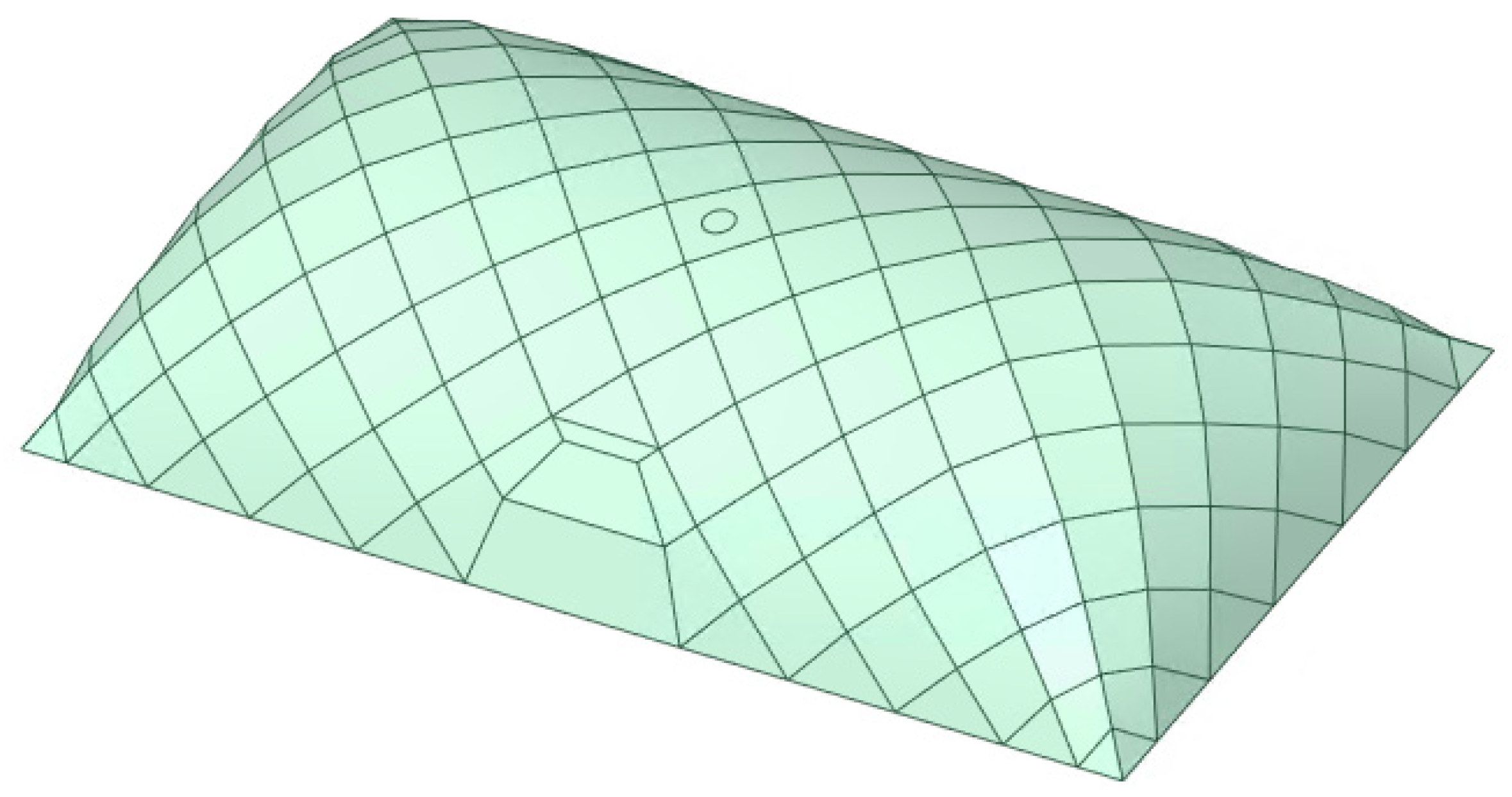

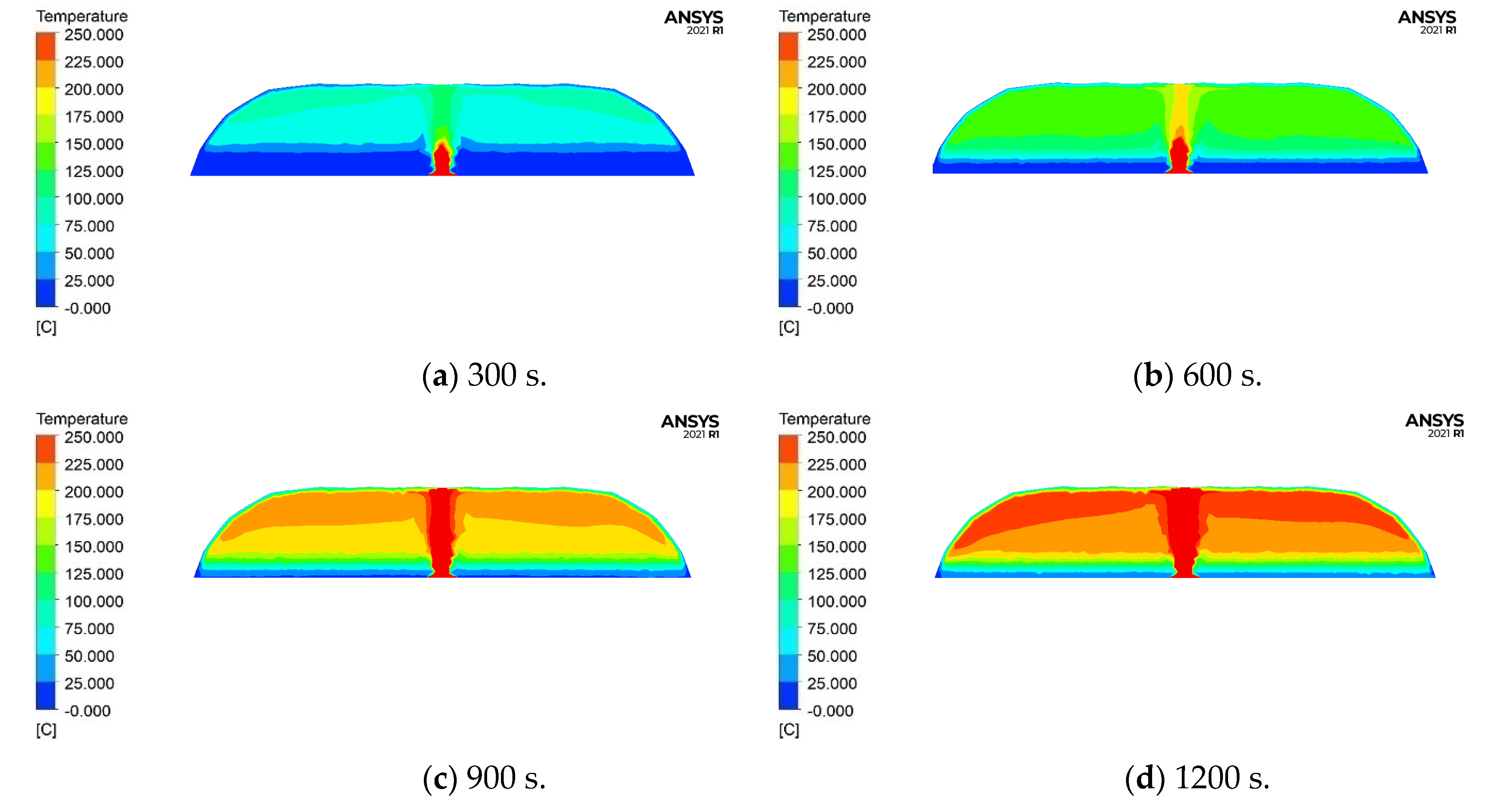


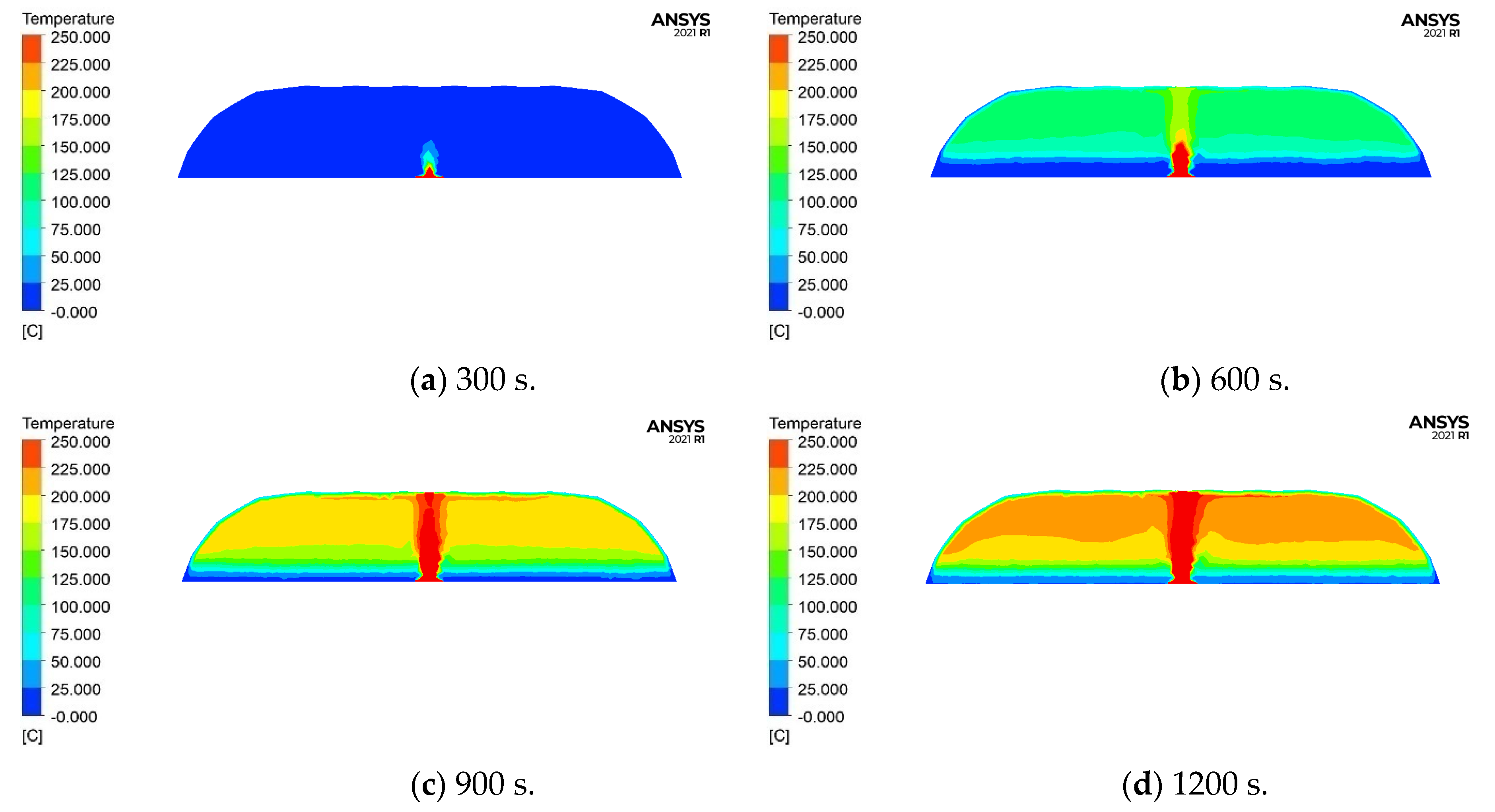
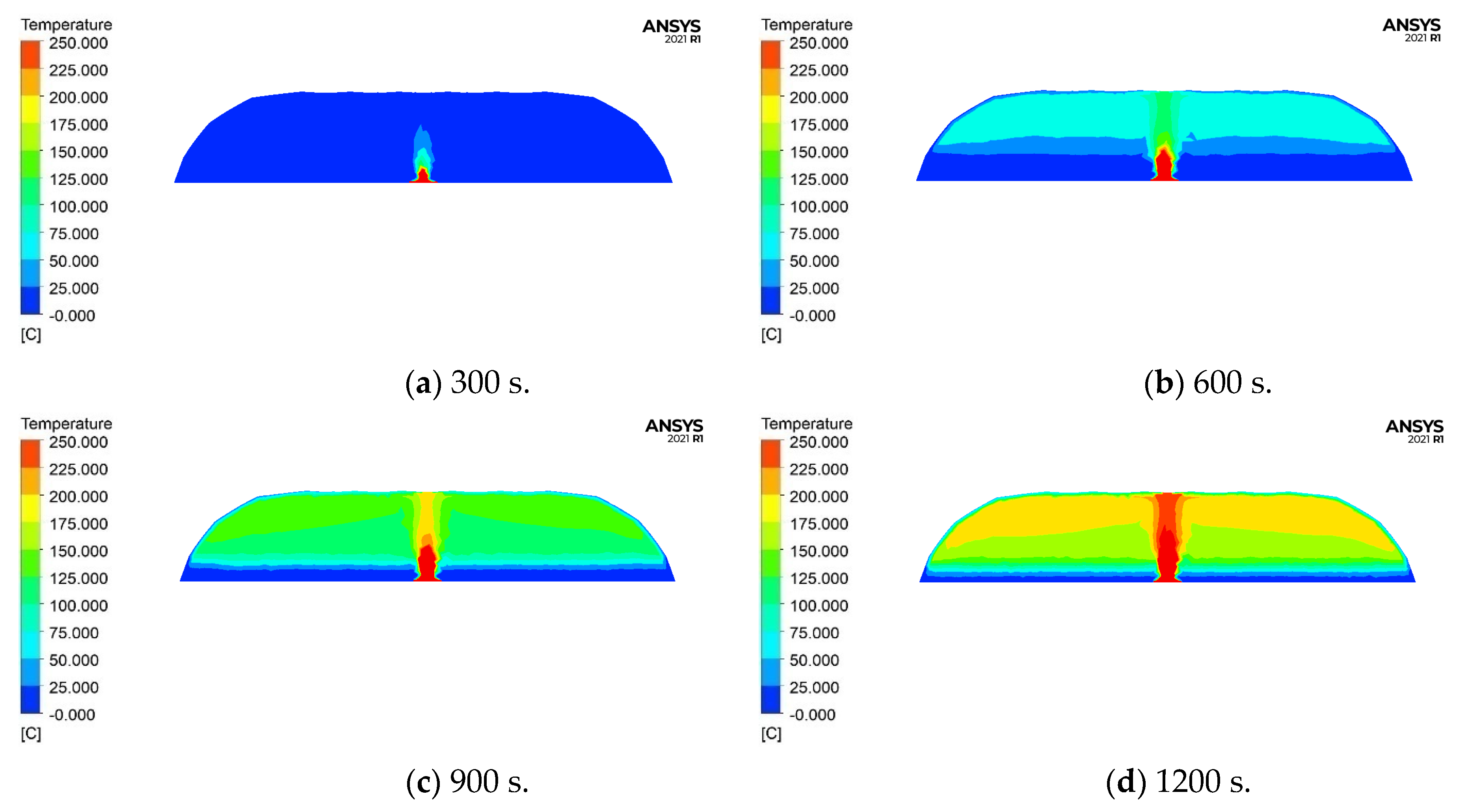
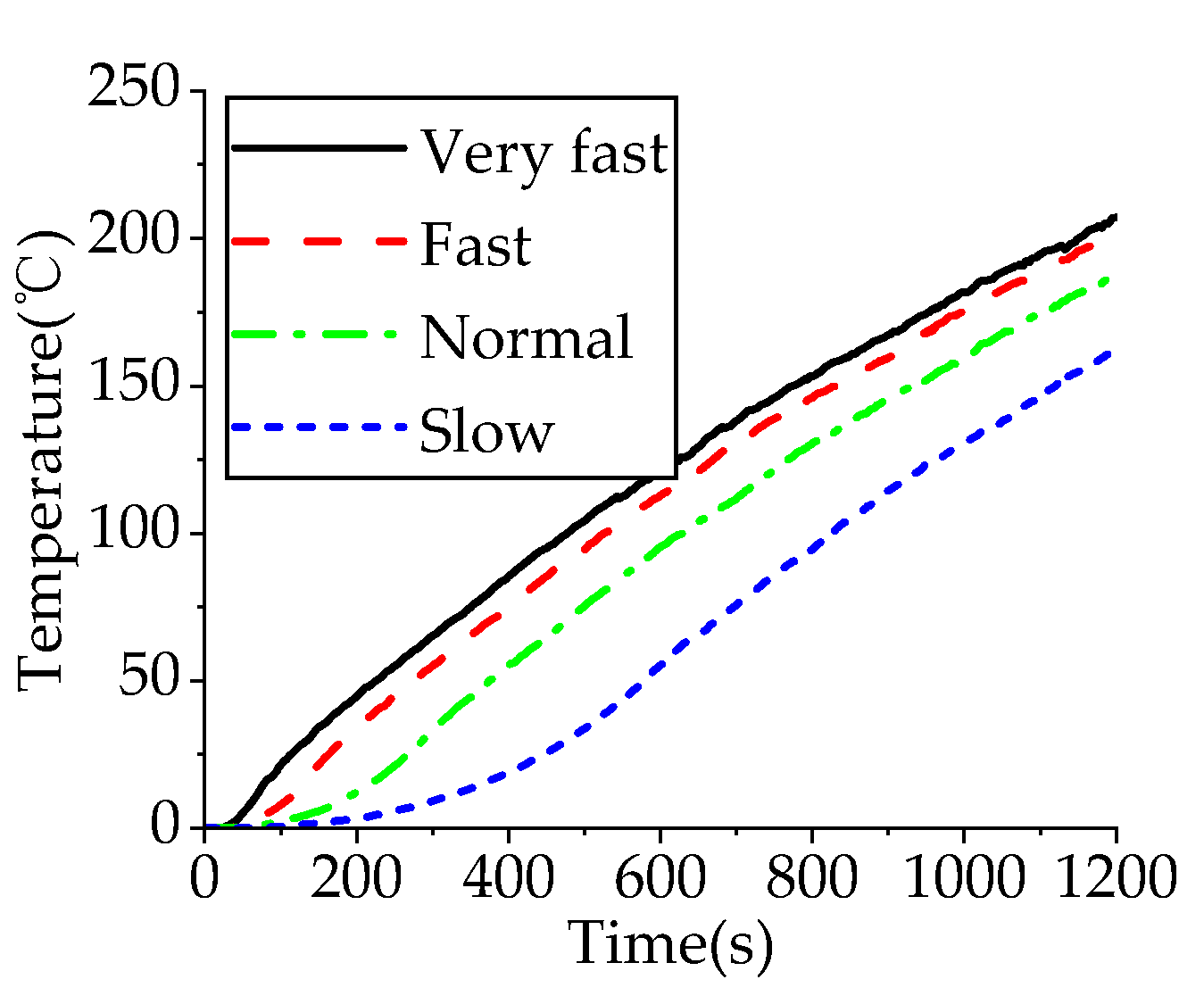
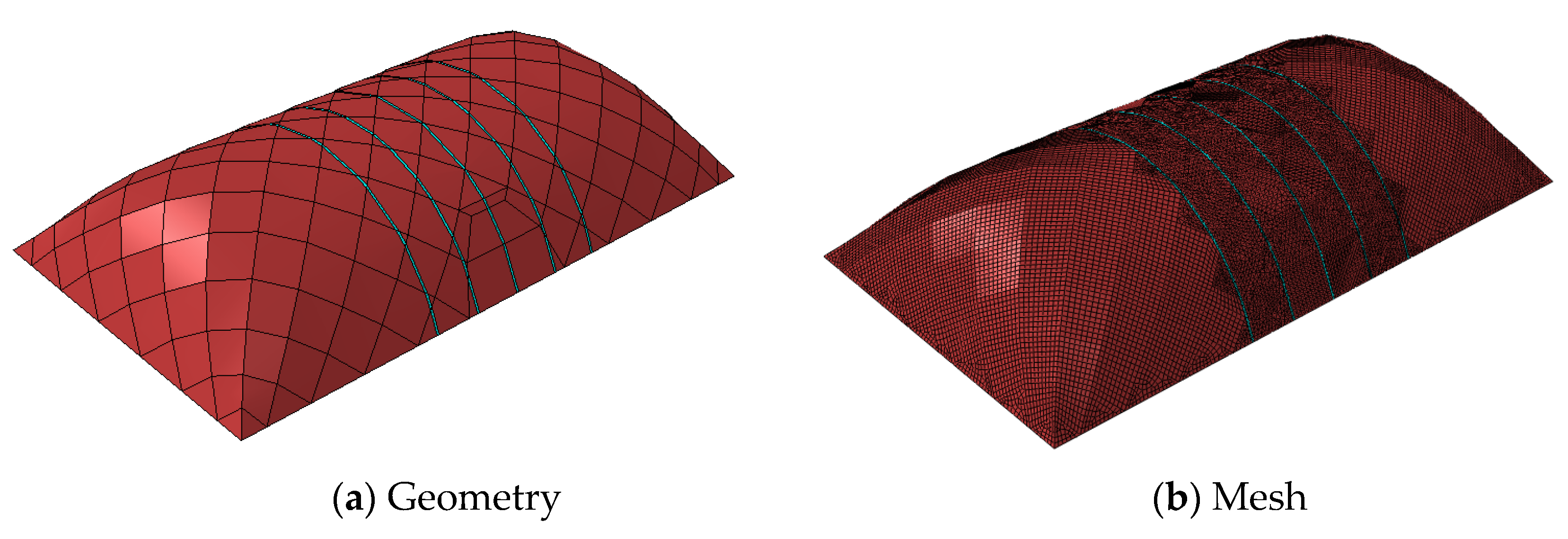
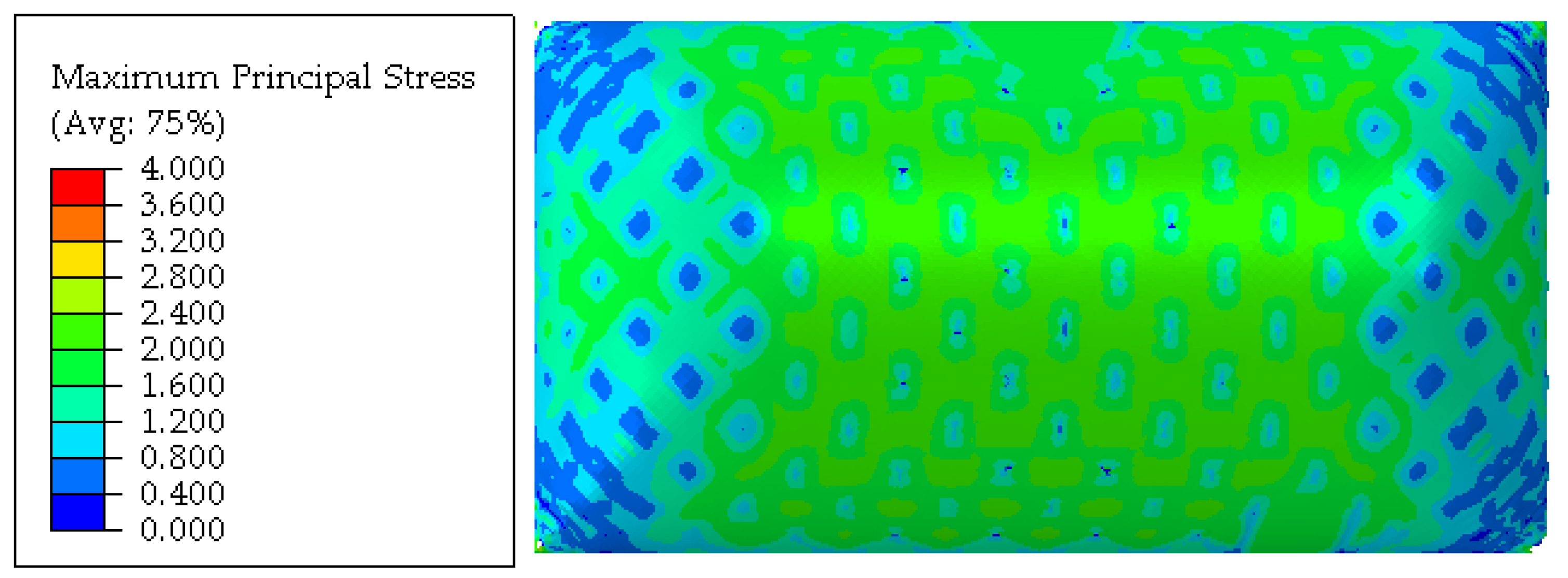



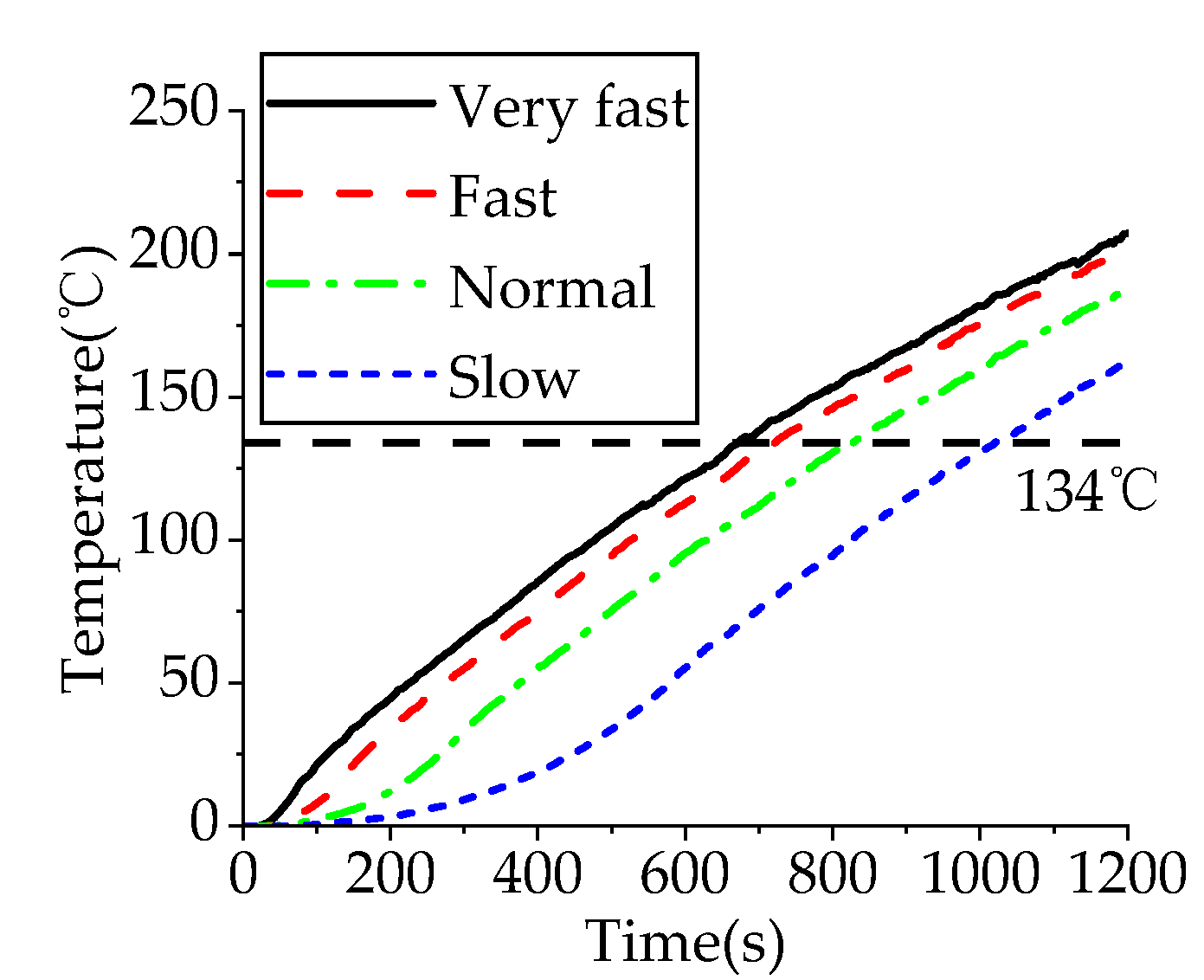
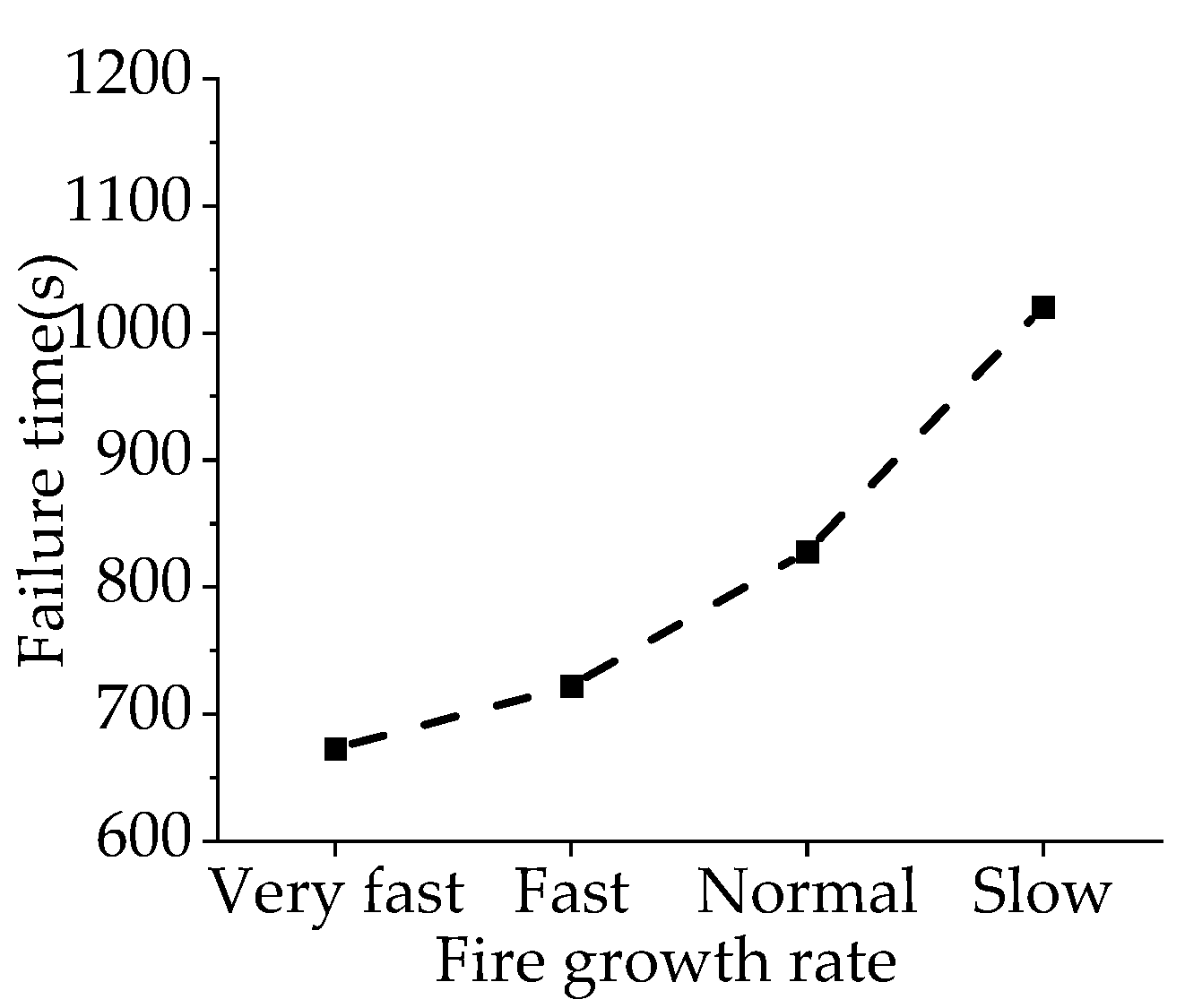


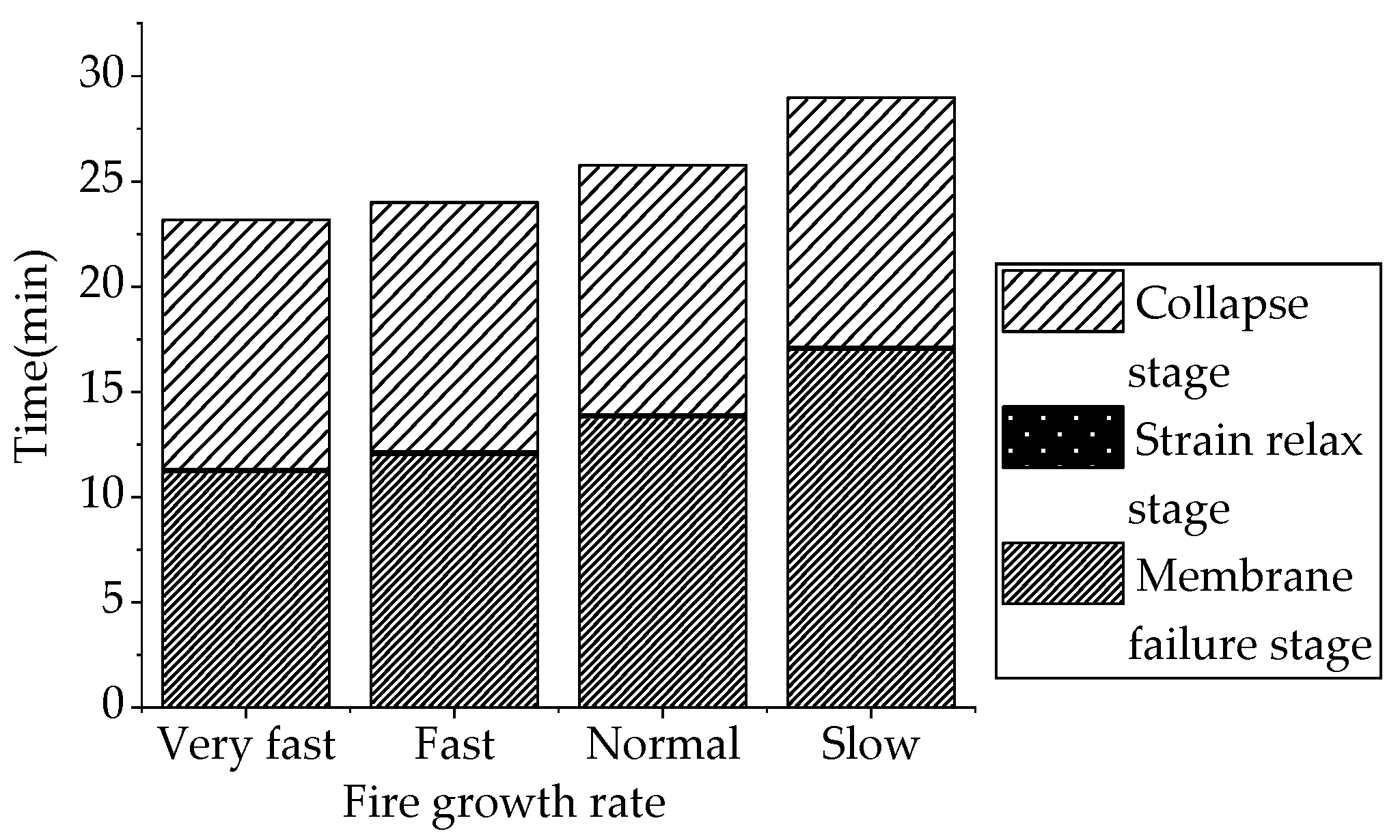

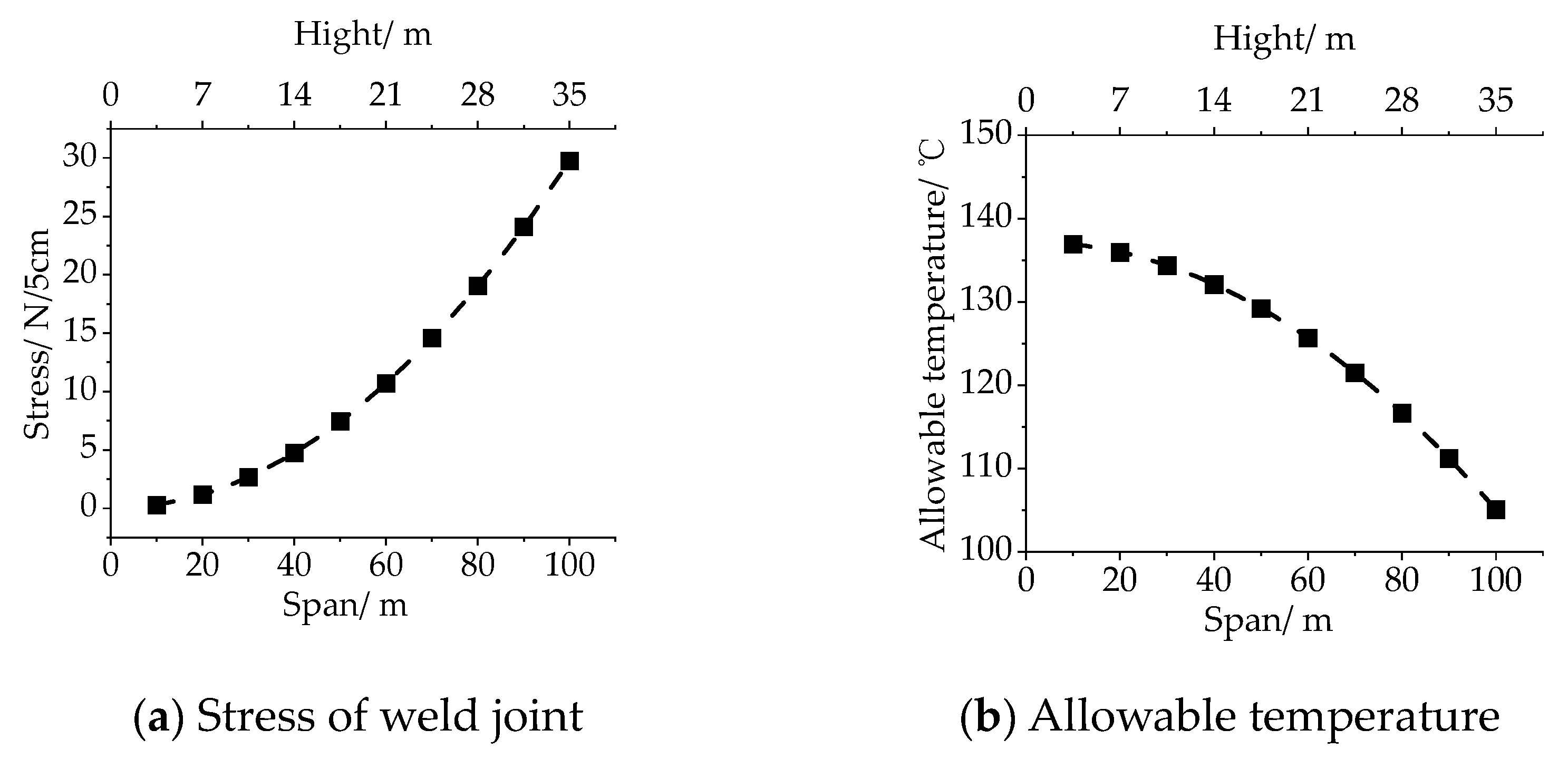

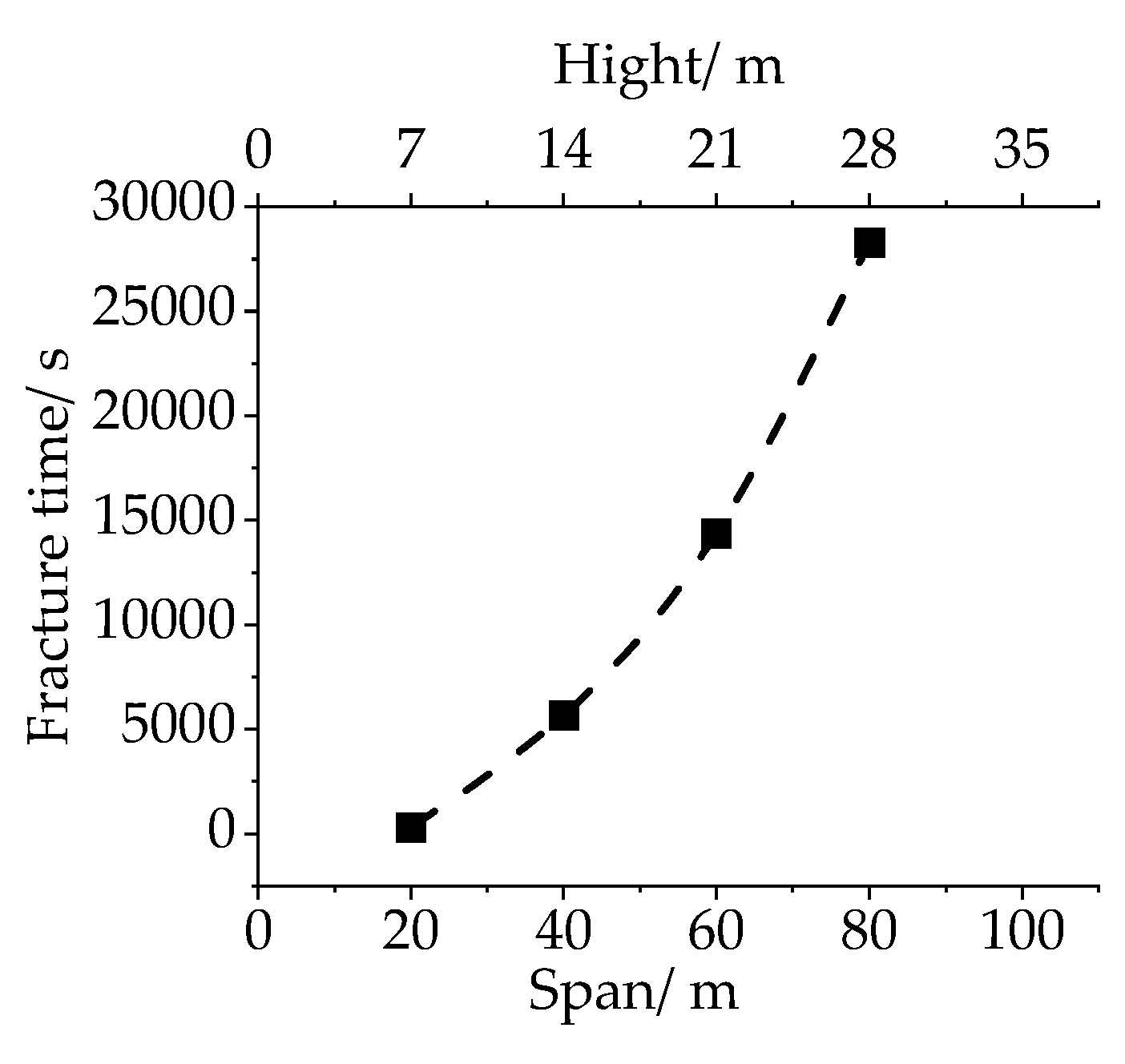

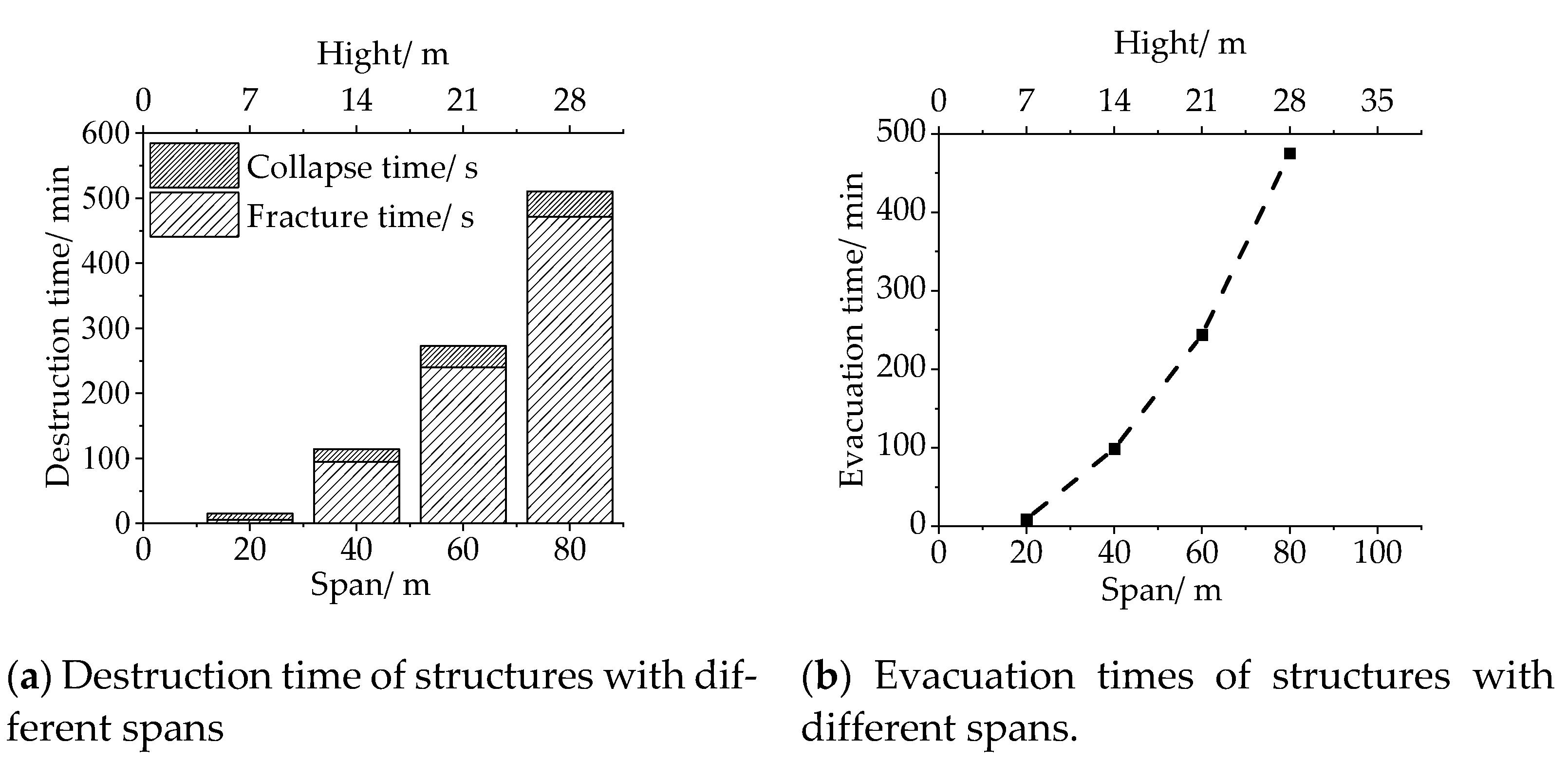
| Fire Development Rate | α | t0 |
|---|---|---|
| Very fast | 0.1876 | 73 |
| Fast | 0.0469 | 146 |
| Normal | 0.0117 | 292 |
| Slow | 0.0029 | 584 |
| Temperature (°C) | Young’s Modulus | Shear Modulus (kN/m) | |
|---|---|---|---|
| Warp (kN/m) | Weft (kN/m) | ||
| 23 | 846.00 | 768.11 | 42.30 |
| 70 | 801.16 | 757.10 | 40.06 |
| 90 | 750.46 | 706.79 | 37.52 |
| 110 | 676.58 | 662.80 | 33.83 |
| 130 | 468.60 | 463.96 | 23.43 |
| Span (m) | Number of Emergency Door | Area of Emergency Door (m2) | Volume (m3) |
|---|---|---|---|
| 20 | 1 | 2.76 | 3358 |
| 40 | 4 | 11.04 | 26,864 |
| 60 | 8 | 22.08 | 90,666 |
| 80 | 16 | 44.16 | 214,912 |
Publisher’s Note: MDPI stays neutral with regard to jurisdictional claims in published maps and institutional affiliations. |
© 2022 by the authors. Licensee MDPI, Basel, Switzerland. This article is an open access article distributed under the terms and conditions of the Creative Commons Attribution (CC BY) license (https://creativecommons.org/licenses/by/4.0/).
Share and Cite
Yan, F.; Sun, G.; Xue, S. Study on Membrane Damage and Collapse of Air-Supported Structures under Fire Conditions. Fire 2022, 5, 162. https://doi.org/10.3390/fire5050162
Yan F, Sun G, Xue S. Study on Membrane Damage and Collapse of Air-Supported Structures under Fire Conditions. Fire. 2022; 5(5):162. https://doi.org/10.3390/fire5050162
Chicago/Turabian StyleYan, Fei, Guojun Sun, and Suduo Xue. 2022. "Study on Membrane Damage and Collapse of Air-Supported Structures under Fire Conditions" Fire 5, no. 5: 162. https://doi.org/10.3390/fire5050162





